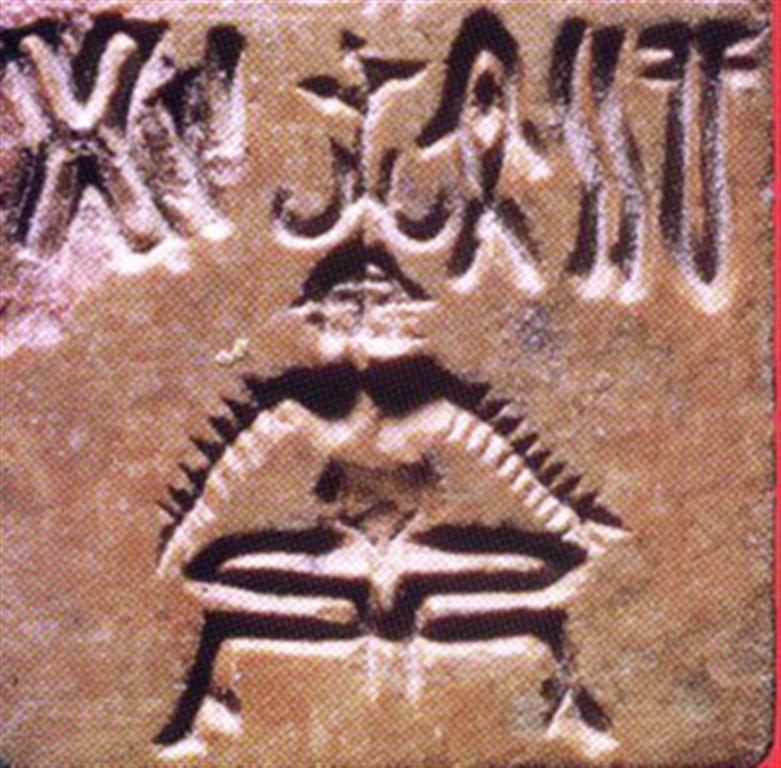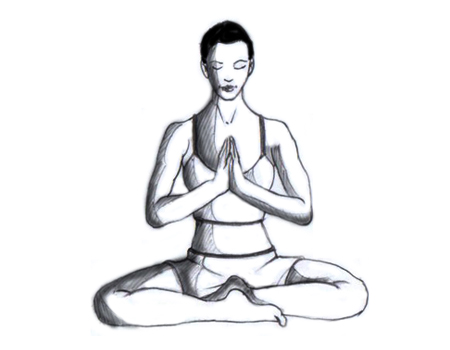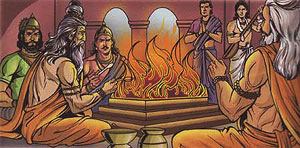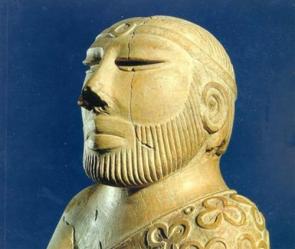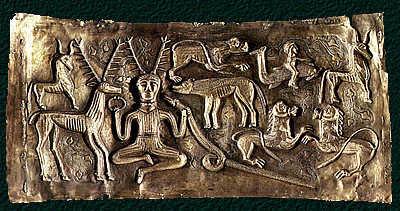The Vedic Harappans, The Disaster of Michael Witzel and Some Flowing Traditions.....
by Bhagwan Singh, Aditya Prakashan, F-14/65, Model Town II, New Delhi,1995
Jaspal Singh
South Asian History has been greatly distorted by the tendentious, colonial and eurocentric rendition of the development of the region. One of the most distorted areas of history has been the question of Aryans and the Indus Valley civilisation.
In this new work, Bhagwan Singh presents an important thesis on the origins of civilisation in South Asia. In the process, he also takes a hard look at the vast body of literature on the subject on this subject that has come down from colonialist scholars and their latter-day descendants.
Bhagwan Singh discusses the "Aryan" problem and settles this long-running debate with convincing arguments. As the title Vedic Harappans, itself suggests, Bhagwan Singh is not treading the old path. For him, the Vedic literature describes the Harappan reality. These are not two different or opposing tendencies. He states,
In short, if we discount the colonial legacy of docile self-denials and falling quickly in line with alien expectations, archaeology was at no stage at variance with the Aryan character of the Harappan civilization.
On the question of the Aryan invasion, he discusses in detail all the arguments put forward by the proponents of this theory. In a chapter titled The Myth Of Aryan Invasion, he points out that "there is neither any literary account of invasion of India by Aryans nor any archaelogical evidence to support such a hypothesis".
He forcefully argues this case: "As we have seen, the Vedic people did not come from outside. The Harappan cities, the first flowering of Indian civilisation, did not fall because of their invasion".
Bhagwan Singh argues with evidence:
Aryans were born with ar/al, the digging stick or hoe in their hands. It was neither their colour, nor their blood nor yet the size and sharpness of their nose which made them proud of themselves. They were proud of their being Aryans or cultivators at a time when the tribes surrounding them were at the stage of hunting and gathering.
It was the Aryans who discovered agriculture and initiated the agrarian revolution and a new mode of production. Earlier the Aryans were called Devas. The term derives from ti/di, meaning burn or shine, and refers to their control over fire.
It was the discovery of fire including the technique of producing, maintaining and controlling it that revolutionised their thinking and prompted them to undertake new ventures.
He concludes that :
The Aryans were primarily agriculturists. They derived their name from this advancement at a time when people around them were lingering at the lower stage of gathering and hunting. Some of them formed their own kindered communities, refused to move ahead and censured them for their madness for ruining the natural sources which provided them liberally.
Later on these Aryans developed into great traders and travelled all over the known world of the time, taking their agriculture, trade, language and customs with them.
Bhagwan Singh also examines the hypothesis of Proto Indo-European language in a chapter titled The Language The Harappans Spoke. He states:
Proto-Indo-European is not a fact but an idea floated in order to displace Sanskrit from the centre of discussion. it the product of a magical realism created for projecting the white man's racial superiority back into the hoary past.
He concurs with the view that Sanskrit is a refinement of different Prakrits which were spoken at the time in India. And that out of these Prakrits, natural languages, a refined and classical language-Sanskrit emerged. "It is admitted (Harmatta 1992) that Sanskrit and Vedic languages are refinements of the Prakrit languages." Bhagwan Singh has dealt with matter at length in his Hindi book, Arya Dravid Bhashyaon Ki Moolbhoot Eikta.
Vedic Harappans is a "must read" book for South Asians in general and those who are seriously interested in History of the region in particular. Bhagwan Singh has put to rest a lot of myths about the history of South Asia and deserves praise for this heroic effort.
yog
Bhagwan Singh versus Michael Witzel!
Michael Witzel: rattled rat at IIC
Bhagwan Singh
22 July 2009
I was really sorry for Prof. Michael Witzel. After all, he was our honoured guest! Dr. Singh should not have pounced on him so mercilessly, playing the cat and the rat game – the cat looking ascetically resigned tossing the rat, the rat pretending to be dead, breathlessly looking from the corner of his eye to judge the cat’s next move, running for his life, only to be pounced upon and tossed up again. The Chair kept smiling all through at this plight of the powerful brainy Harvard Professor of Sanskrit!
Frankly, I enjoyed the wild play. Prof. Witzel was in a state of trauma: nervous, edgy, twitching his lips, dropping his eyelids recurrently, looking askance to avoid his interlocutor, constantly using his hanky to rub his nose, murmuring something inaudible to explain his errors, occasionally seeking help from his votaries who were present in good number, but more ignorant than their demi-god, and hence themselves dazed. Singh smiled all the way, his smile mischievous, eyes sadistically aglitter, untrue to his true nature, but true to the occasion.
Rgveda
The occasion was a lecture on the Rgveda by Prof. Michael Witzel, at the India International Centre, on 10 July 2009. Presided over by Dr. Kapila Vatsyayan, it was attended by scholars of different hues and expectations. No one suspected that Witzel with his claim to be a ranking Vedic scholar knew so little that he could not answer a single query. Indeed, he appeared blank as far as the Rgvedawas concerned. He rose nervously to speak on the Veda, but actually spoke on the Aryan migration from Afghanistan to Punjab !
The lecture merely reiterated what Prof. Witzel has written years ago: that north-western India was populated by Munda speaking people when Indo-Aryan speakers arrived on the scene. Old Indo-Aryan was influenced by the substrate Proto-Munda. He proposed a time bracket of 1500-1250 BC for composition of the Rgveda and suggested Book IV and Book VI were the oldest, advantage Book IV.
Witzel painted Rgvedic society as nomadic pastoralist, illiterate and with little interest in agriculture and sedentary life. There was virtually nothing in his speech that was not lifted from nineteenth century archives. He showed no awareness of recent researches in archaeology, anthropology, literature or historical linguistics, and presented even Kuiper with his pathological distortions.
Many archaeologists and professors of history attended the lecture, including your writer, Vedic scholar Bhagwan Singh. When the floor was thrown open for discussions, Bhagwan Singh introduced himself as the author of The Vedic Harappans, and said that his data contradicted each and every statement made by Witzel; he sought permission to exchange notes on a few issues. With the Chair’s permission, Singh said:
- You have reordered the Rgvedic strata, rating IV and VI to be the oldest and the rest belonging to intermediate and late stages. I have no objection to your sequence, but find your chronology miserably on the lower side. There is a reference to white pottery in one verse in Book IV (4.27.5). White pottery is a distinctive feature of Hakra Ware dated to 3000 BC. This goes against your dating of 1500-1250 BC for the Rgveda.
Witzel was dumbstruck. He murmured something inaudible, avoiding the audience, looking sideways. He tried to explain that the sequence arranged by him was based on the number of verses in a book, the smallest being the oldest. It caused Kapila ji and others to smile openly. I could not make out the reason and reminded him that Book IV is shorter than Book VI; but the shortest book is Book II! So here again, he was caught on the wrong foot.
He hesitantly managed, “There is no evidence of chariot or horse in India earlier than the mid-second millennium.”
- But Professor, the aśva in Rgveda, whatever could it have been, was brought from sea bound areas, even the aśva in the horse sacrifice, mentioned in Book I, hymn 163.
Prof. Witzel had no choice but to bite his lips in desperation.
- You say that the wheel and chariot were invented by Aryans when they were in Central Asia , but in the Book IV itself, Bhr.gus are given the credit for manufacturing wheels (4.16.20). Chariot and wheel was therefore not Aryan, but a Dravidian invention.
Witzel pretended that the inventors might have been Aryans and manufacturers Dravidians! He now forgot the antiquity of Book IV, which according to his suggestion, could have been written in Central Asia, older even than Book VI, composed entirely in Northern Afghanistan ; Dravidian speakers must have been there as well.
- You talk of substrate effect of Proto-Munda and suggest no role of Proto-Dravidian at the early stage. But Kipper had concluded that three ethnic groups participated in a cultural process. The three are conspicuously present in the Rgveda, Bhr.gus Dravidian, Angirasas Mundari, besides the Sanskrit speakers.(Note 1)
Prof. Witzel mumbled something for a minute; his nervousness was apparent in his evasive gestures.
Kapila ji must have taken pity at his visible discomfort. She invited others to raise doubts, if they had any. Someone at the extreme end of the hall asked a question on the distorted reading of the Sankhyayan Śrautasutra, which had exposed his culpability half a decade back. Witzel responded by referring to an article written by him, without telling us what his defence was!
After a few worthless queries, the debate shrunk back to Michael Witzel, Kapila Vatsyayan, and Bhagwan Singh.
- The problem with you, Professor, is that you are not familiar with the content of Book IV even. Hymn 57 of Book IV gives a graphic depiction of advanced agriculture, with a plough almost similar to the one that was common in India up to the mid-twentieth century, drawn by a pair of bullocks and driven by a ploughman in service. And in one of the Ŗics, the poet talks of milking the earth as a cow, year after year. It testifies to advanced agricultural activities with sedentary population and belies the myth of nomadism, pastoralism, and barbarity.
The Chair could not hold her laughter; Witzel shook in dismay.
The last nail was hammered by Kapila ji herself. In a jocular vein, she said, “The theme of the lecture was Rgveda. Vedic poetry is known for its sublimity and rare beauty. I expected Prof. Witzel to speak something on it, but he did not say even a word on the theme.”
Witzel agreed that the Hymns on Uşā are really beautiful.
I interjected, “not only Uşā Sūktas professor, the entire Rgveda.Some of it could never be surpassed, such as the Nāsdīya Sūkta, with such expression as tama āsīt tamasā gūlhmagre, darkness was entrapped within darkness.
All in all, it was an interesting evening, if not for the presentation by Prof. Witzel, then for his discomfiture.
Prof. Bhagwan Singh is a Marxist scholar who accepted the archaeological evidence against the theory of Aryan invasion of India
The Traditions Still Flowing.......
1) BANGLE TRADITION
DANCING GIRL OF MOHENJO-DARO
DANCING GIRL OF MOHENJO-DARO
Compare these statues with modern day gypsy women of north-western India.Notice the similarities between bangles on their hands.
These women are Indo-Aryans,they speak Indo-Aryan languages and they have Indo-Aryan gypsy culture.This bangle tradition lives on from the times of Harappan civilization to this day.
2) THE GREAT BATH OF MOHENJO DARO
THE GREAT BATH
Similar bathing tanks were also discovered in Dholavira.
Compare with modern day Hindu temple ponds.
Ritual bathing(Sanskrit Snana) is very important for Hindus from the times of Harappan civilization.For example,Kumbh mela is a very sacred festival of Hindus
3) VEDIC SYMBOLISM
The seals and arts of Indus valley offers many Vedic symbolism such as Chakra,Sacred Pipal leaf,Swastikas etc...which are sacred for Hindus and Buddhists to this day.


4) Yogic postures
Indus seals shows many Yogic postures which are practiced to this day.



5) YOGIC MUDRAS
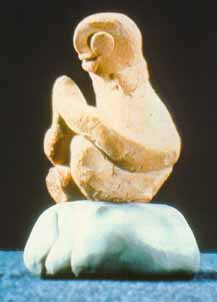
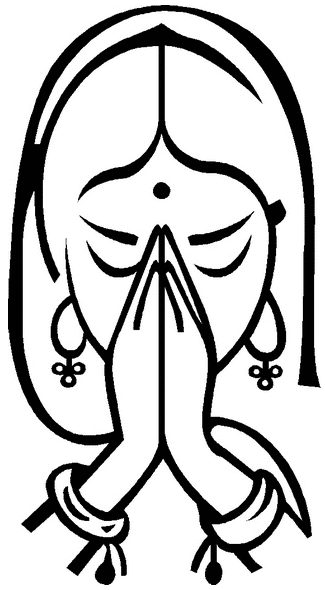
6) Shiva Linga
This is a Shiva Linga from Kalibangan it is exactly the same as the one which Hindus use today.Many other Shiva Lingams were also found from Mohenjo-Daro.

7)Fertility Goddess cult
This is a fertility goddess figurine from Harappan civilization, compare it with the figurines below.Notice the headdress and flowers,they represent the same goddess.

Mauryan(400 BCE)
Gandharan (200 BCE)
These figurines are from final 2500 YBP,which means this Goddess cult was active during Mauryan times and Gandharan times among Indo-Aryans.Mauryans and Gandharans were undoubtedly Indo-Aryans.This extinct cult must have been contemporary to the Hinduism Buddhism and Jainism at that times.It may be non-Vedic,but still it was practiced by Indo-Aryans.
8) Fire worship and fire altars.
These fire altars are from Kalibangan and Lothal respectively.These fire altars are exactly similar to the Vedic fire altars used fro fire sacrifices or Yajnas,which are core of the Vedic faith.It is conducted by learned Brahmins.At Kalibangan row,of 7 fire altars were found at a citadel.Sites like Rakhigarhi,Banwali also have presence of fire worship.
3) VEDIC SYMBOLISM
The seals and arts of Indus valley offers many Vedic symbolism such as Chakra,Sacred Pipal leaf,Swastikas etc...which are sacred for Hindus and Buddhists to this day.


4) Yogic postures
Indus seals shows many Yogic postures which are practiced to this day.



5) YOGIC MUDRAS

These figures in lotus postures from Harappan civilization shows "Anjali Mudra" or Namaste practiced by all major Indian(Dharmic) religions

6) Shiva Linga
This is a Shiva Linga from Kalibangan it is exactly the same as the one which Hindus use today.Many other Shiva Lingams were also found from Mohenjo-Daro.

7)Fertility Goddess cult
This is a fertility goddess figurine from Harappan civilization, compare it with the figurines below.Notice the headdress and flowers,they represent the same goddess.
Mauryan(400 BCE)
Gandharan (200 BCE)
These figurines are from final 2500 YBP,which means this Goddess cult was active during Mauryan times and Gandharan times among Indo-Aryans.Mauryans and Gandharans were undoubtedly Indo-Aryans.This extinct cult must have been contemporary to the Hinduism Buddhism and Jainism at that times.It may be non-Vedic,but still it was practiced by Indo-Aryans.
8) Fire worship and fire altars.
These fire altars are from Kalibangan and Lothal respectively.These fire altars are exactly similar to the Vedic fire altars used fro fire sacrifices or Yajnas,which are core of the Vedic faith.It is conducted by learned Brahmins.At Kalibangan row,of 7 fire altars were found at a citadel.Sites like Rakhigarhi,Banwali also have presence of fire worship.
.
AMT proponents are completely ignorant about these cultural similarities between Harappan civilization and Indo-Aryan culture.
Special thanks To Yajna...............................















